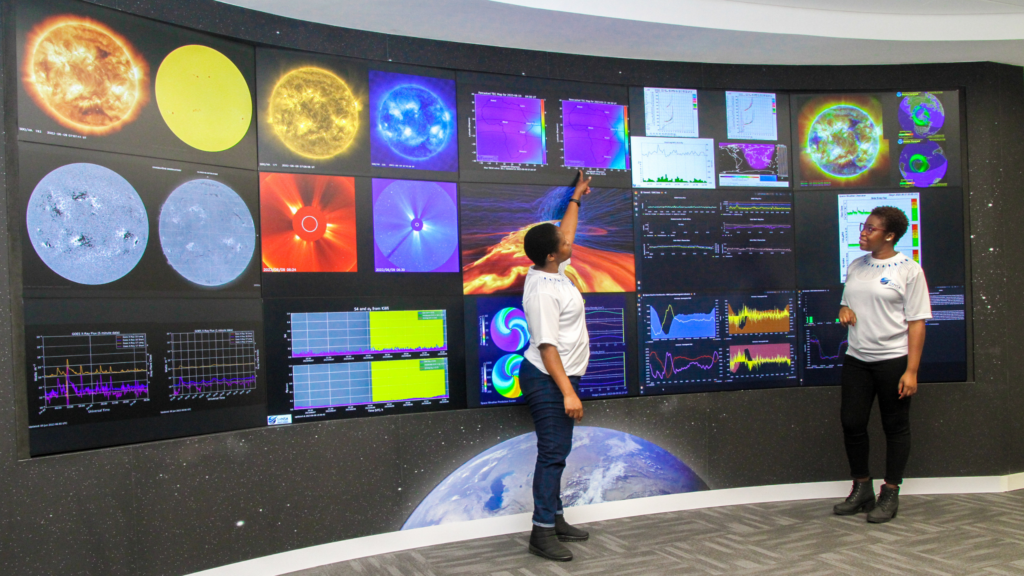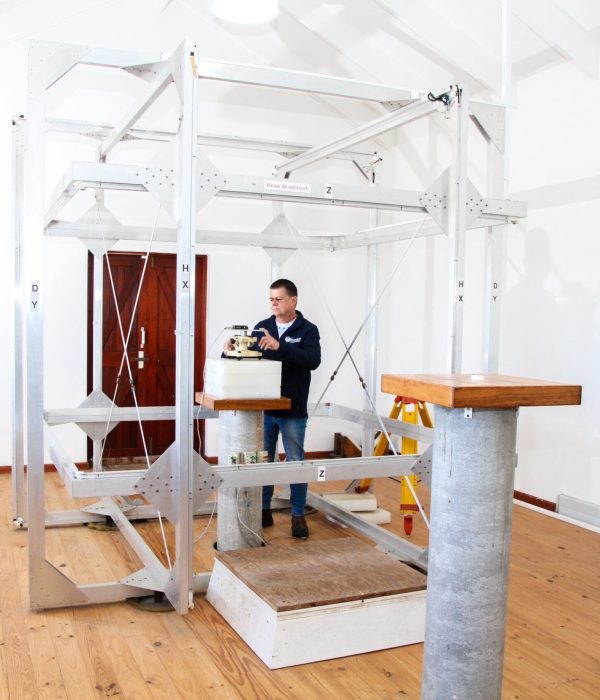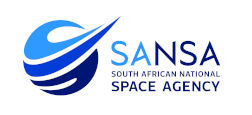Space Science
- SANSA
- Products & Services
- Space Science
Space Weather Centre

SANSA operates the only operational Space Weather Warning Centre for Africa that forms part of the International Space Environment Service (ISES). SANSA’s Space Weather Centre is designated by the International Civil Aviation Organization (ICAO) to provide space weather information to the global aviation sector, along four global centres. The Centre provides an important service to the nation and the region by monitoring the Sun and its activity, providing space weather forecasts, warnings, alerts, and environmental data on space weather conditions to the global aviation sector, defense, government and private-industry users in Africa to mitigate the effects of space weather on technological systems.
SANSA has been monitoring space weather since 2007 and launched the first Space Weather Regional Warning Centre for Africa in 2010. This centre was upgraded in 2018. In 2022, SANSA launched its operational 24/7 Space Weather Centre in Hermanus.
What We Do
- Real-time forecasting and monitoring of space weather to reduce and mitigate the impact of space weather on technology, critical infrastructure and human activities. Provide tailored information for space weather-related requirements, such as HF propagation prediction to clients.
- Facilitate communication and service co-ordination regarding space weather, particularly during periods of enhanced solar activity and in the event of extreme space weather activity.
- Promote understanding of space weather and its effects among users, researchers, the media and the general public
Client Support
SANSA provides support by means of the provision of space weather information and training. Clients use this information to protect a wide range of systems and technologies that may be affected by space weather. These include but are not limited to:
- HF radio systems, such as communication and surveillance systems
- Geophysical exploration, power systems and long pipelines
- Satellite, spacecraft and airline operations
- GPS and other navigation systems
WHAT WE OFFER
Space Weather Training Courses:
SANSA offers training courses in space weather, its impact on technological systems and HF radio propagation as well as on how to generate your own frequency predictions. Courses are tailored to suit client requirements and are hosted at SANSA in Hermanus or at a venue convenient to the client. The training provides a basic understanding of space weather, its importance and how to mitigate space weather effects.
Activity Indices:
SANSA produces daily and weekly Smoothed Sunspot Numbers (SSN) and Edective Geomagnetic Activity Index (Qe) data for a period of 103-days. SSN and Qe are indices required as inputs to HF propagation software such as (IOCAP). These indices are required to generate their own frequency predictions.- 3-day prediction of SSN and Qe
- 103-day and 7-day average predictions
High Frequency Predictions:
The Space Weather Centre provides daily and weekly High Frequency (HF) prediction graphs for different signal paths. Special frequency predictions are also available on request up to two months in advance. Plots of Signal-to Noise Ratio (SNR), Take-off Angle and Maximum Usable Frequency (MUF) vs. Time are available.- Weekly and daily predictions for general paths
- Specific daily predictions
- Special frequency predictions
Solution
SANSA Space Weather Centre provides alerts and warnings on a 24/ basis from its operational Space Weather Centre in Hermanus.
- Coronal hole high-speed solar wind streams
- Coronal Mass Ejections (CMEs)
- X-ray solar flares
- Geomagnetic storms
- Ionospheric storms
- HF fadeout
- Increased radiations at aviation altitude
T-Index Predictions
SANSA produces daily T-indices and weekly averages for a period of 55-days. The T-index is the ionospheric index that indicates the highest frequencies that will be reflected from regions in the ionosphere. This index is an input parameter of HF propagation software.
- 3-day T-Indices
- weekly averages if T-Indices
- 55-day T-Indices
Magnetic Technology

The aviation sector is a highly regulated industry with detailed requirements for relevant applications in the military, civil and private operations environment. A key application is that of the calibration of landing compass equipment for aircraft. International safety regulations require that there be mechanical compasses on board all aircraft and marine vessels, for emergency loss of power conditions, in addition to the more modern Global Positioning System (GPS) systems with electronic compasses. The compass calibration procedure is a highly specialised procedure requiring scarce expertise and a magnetically clean environment to manually adjust the compass and compensate for the host platform’s magnetism and alignment to the Earth’s magnetic field.
Furthermore, the calibration of these landing or reference compasses can only be done in close physical proximity of magnetic observatory instruments (e.g. D/I inclinometer) and these instruments can only operate in a magnetically clean environment. The South African Civil Aviation Authority (SACAA) requires every aircraft landing compass to be calibrated once per annum. Linked to this is the procedure for aircraft compass swings; a procedure where the magnetism of the aircraft is measured and calculated and the aircraft’s compass is adjusted accordingly. This procedure is usually only performed within a magnetically surveyed area.
SANSA’s facilities in Hermanus are well suited for characterising and calibrating magnetic sensors, as well as identifying the magnetic signature of dynamic platforms prior to sensor integration. SANSA is recognised as a national expert in various magnetic technology applications. Working closely with players in the aviation, defense, maritime and local space industry.
WHAT WE OFFER
SANSA is host to a wide range of state-of-the-art equipment and infrastructure to provide specialised magnetic technology related services.
- Calibration and maintenance of landing compasses.
- Presentation of training courses regarding magnetism and compass swing procedures for aircraft and marine vessels.
- Magnetic navigation ground support.
- Geomagnetic data and field modelling over Southern Africa.
- Calibration and evaluation of systems containing magnetometers.
- Acquisition, evaluation and calibration of magnetometers for space and other navigation applications.
- Magnetic and electrical field measurements and management.
- Execution of magnetic tests according to international standards such as RTCA DO- 160G, IEC 945
Equipment and Infrastructure
Our state-of-the-art equipment and infrastructure includes:- Large 2.4 m tri-axial Helmholtz Coil system used to evaluate and calibrate various magnetic sensors, systems and magnetic equipmen
- Zero-field (≤ 10 nT) magnetic shielding chamber for magnetic evaluation of sensors.
- Non-magnetic temperature chamber (-50°C to + 70°C) for functional temperature evaluation of magnetic sensors, systems and magnetic
- High temperature Superconducting Quantum Interference Device (SQUID) for the recording of very faint geomagnetic signals
- Various highly sensitive scalar and vector research-grade magnetometers for measurement and evaluation of magnetic environments.
- Design and construction of spesialised coil systems
- Consultation on magnetic related projects


